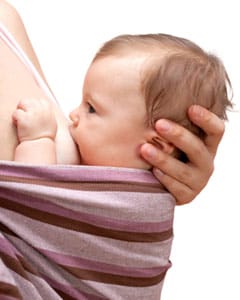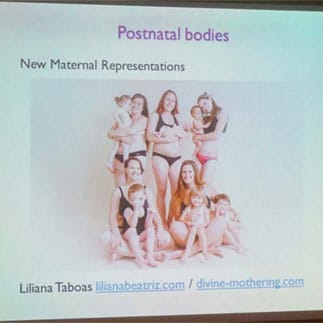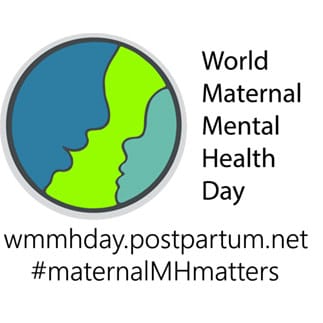What is the distinction?
I believe that one of the difficulties that women experience during breastfeeding is the pull between cultural femininity and biological femininity. This distinction was first brought to my attention in Karen Pryor’s book, Nursing Your Baby (which I believe is out of print now). Cultural femininity is comprised of many stereotypes that limit a woman’s expression of self, mold her personality, and affect her body image. Very often this is ruled by the media, which has very specific ideas of what’s considered ‘feminine’, and it’s rarely an empowered definition. Biological femininity is the expression of feminine power through pregnancy, childbirth and breastfeeding. When breasts became viewed as sexual objects and society began to glorify sexual attractiveness, the exposure of breasts became limited to private moments. We only show breasts, or should I say nipples, to our partners and not to anyone else. Such a taboo is bound to have an impact on the choice to breastfeed, and can also manifest as a stumbling block for those who do breastfeed. If a partner is uncomfortable with the biological aspects of breastfeeding, the mother will often develop issues that will make it difficult if not impossible to nurse her baby, in order to make her partner more comfortable (all on the unconscious level). Since our sense of sexuality is reshaped during the childbearing year, some women are unwilling to trade off that intimate contact with a partner if they sense breastfeeding conflicts with that.

Why is it more acceptable to see nubile young women glamorously dressed in décolletage so deep that it meets the waistline, but it’s obscene to see a mother feeding her baby at the breast? This is a debate that is currently trending on Facebook, which removes images of mothers’ breastfeeding, but shows all manner of other sexualized images of breasts. There is a cultural distortion in elevating the useless shape of the body curve as having more significance than the functional aspect of the glands. These glands have produced the perfect food to nourish our babies, like no other substance on earth. Society falls short of encouraging mothers to go the natural route in a practical way. Lactation is the natural state of the mammary glands. Choosing not to breastfeed is the denial of this natural aspect of our maternity. I believe that education for partners is essential for increasing awareness of functioning breasts as sources of nurturance, food, and comfort for infants, and that in the scheme of things this is a relatively short time in the life of a woman. I can say that now, having reached an age of maturity where I can reflect on the five years in total that I have breastfed my four children.

A personal experience with both
I am uniquely qualified to discuss this topic, having once been a Playboy bunny and a nursing mother. Talk about glorified sex objects! However, it must be said that I met my (ex) husband in the Playboy club, and when we started having children, my second birth inspired this career choice for me (https://dianespeier.com/and-then-along-came2/), so in some ways the cultural and biological overlapped. I have personally experienced both cultural and biological femininity, and there is no comparison. Cultural femininity is defined by others. Here’s a secret: those of us who were not zaftig (well endowed) used creative ways to make our breasts look larger in our costumes – it was my legs, not my breasts, that got me hired! Biological femininity is defined by nature and can be enormously fulfilling, and for me childbearing is when my breast size increased. My feminism helped me to transcend the stereotypes of cultural femininity. Susan Brownmiller wrote the book Femininity (1984), and with regard to breasts she sums it up perfectly: “…the cultural belief that breasts are primarily decorative and intrinsically provocative seems related historically in Western civilization to the elimination of the routine sight of breasts as a means of nourishing the young” (p.44, emphasis mine).
Restoring the breastfeeding landscape
When bottle feeding became the norm in the 20th century, the sight of mothers breastfeeding disappeared from the landscape. Before this, children grew up observing this natural expression of femininity, and girls were primed for the day when they would become nursing mothers. This visual display is indeed reappearing, as the debate about breastfeeding in public can be a rancorous discourse – I’m thinking of the UKIP leader who recently shared his view that women should go in the corner to breastfeed their babies. I guess the corner is better than the toilet, which is what many women have to resort to when their babies are hungry in an inconvenient location and time. I think it’s time to see nursing paraphernalia, like nursing pads, pumps, or bras, in other media besides parenting and baby magazines. Imagine commercials selling these kinds of products on television! That would normalize things considerably. We would be fostering an acceptance of our biological femininity to offset the limitations of cultural femininity. We would be expanding the consciousness of society to accept breastfeeding as the natural biological experience that it is. And many more women would be able to experience a positive experience of nursing their babies without conflict that they must give up their sexuality in the process.
What do you think?

I hope you have enjoyed this post. Use the search bar below to find other interesting content on this site.
Post Categories








thankyou for this fabulously eloquent post. It has provided me with the understanding I can draw on to assist mothers with newborns (& their partners) to have a healthier & more fulfilling experience from all concerned when it comes to breastfeeding. This needs to be shared widely in particularly western communities where breastfeeding has become something like a ‘child that should not be seen or heard’. Bravo to the feeding beasts & nipples that are one of nature’s most ingenius beautiful individual practical nourishing ways to foster secure attachments between mother and baby. And we know this leads to greater emotional regulation this healthier relationships.
Economically speaking I’m figuring saving millions in dollars not having to be spent on trying to fix ‘people’ whose issues started because their mothers were culturally oppressed around breast feeding.. It’s similar to the burka issue. Damaging to women & in turn to their children (as it interferes with reading facial cues we need for to develop empathy).
Sounds like we are singing from the same hymn sheet, Marie. And thank you for the compliment. I’m glad you appreciate what I wrote and that it bears sharing widely. Your analogy to the burka makes me wonder if that has something do with why Islam can be such a violent culture – children growing up without developing empathy because facial cues are hidden. Thank you for that insight. Namaste.
Islam is a religion not a culture. Islam is a peace preaching religion. Fanaticism and extremism of violent individuals is exactly that and not representative of all Muslims. Women wear a burka only when in public, at home they would not have their faces covered. I agree with your article but not such an inaccurate, sweeping and generalised reply to Marie.
Well, Dee, you are partially right about generalization, though what I’ve mused about is not totalizing at all. I said that Islam can be a violent culture, not that it is one. Thank you for reminding us that a burka is only worn in public. I also believe that Islam is a religion and a culture, but that the extremism does not represent all Muslims.
Dear Diane,
Thank you for writing this article, I wonder for how much longer do we have to continue speaking up in defense of our true empowered femininity, like our sexuality, this whole area of our lives is still in need of much light so that the young people in particular can be free. Blessings, Giselle
Giselle, rather than the dichotomy femininity and sexuality, we could synthesize them as sexual femininity. Re-members the Madonna/Whore split. I feel another blog coming on to explore that!
I agree with you Diane. Another important influence is whether or not women and their partners were BF. It is while we are being BF as infants that we are imprinted. The infant who is not BF carries a biological longing for that which its body longed for, the only thing that millions of years of evolution had programmed it to want and it had to compromise its integrity to live. This is exploited by Coca Cola who say they have ‘the real thing’ That tapes into the mass infant longing.
The time at which a mother was weaned herself as a baby can be a time of crises with BF when her baby is that age too. Milk might seem to dry up or mastitis can occur. Understanding this possible genesis can be very helpful.Babies are angry when they are weaned too soon. The partners BF history will also influence his attitude to his child being BF.
Thank you for your article. Love and blessings, Rachana
These are interesting ideas, Rachana, which I have also considered over the years. However, success with breastfeeding is multifactorial. I know that my daughter, who was nursed for 2 years, struggled with breastfeeding because her mindset was anxious. I was not aware of the anniversary effect on breastfeeding weaning so thanks for that enlightenment.
Dear Diane
You make some very good points. I fed both my sons for as long they wanted to (14m and 10m) and found it a very rewarding experience. Because I was part of a group where most of us were breast-feeding I never really had any problems with people’s attitudes. Which is as it should be.
I am glad you’re making an issue of this, on behalf of those who might not be as lucky as I was.
Joy
Dear Diane
Thank you for an excellent commentary highlighting the difference between “cultural and biological femininity”. I am in agreement with you that a majority of women let society dictates which is healthy and natural for their babies and their health and well-being because the mass media does not promote breastfeeding. Therefore, it is not chic and sexy according to society’s standard to breastfeed our babies in public. On the other hand, it is chic and sexy for a pregnant woman to pose on magazine cover nude. Society has double standard when it comes to women showing off their femininity by exposing their breast to sell magazines, perfumes, and other products to make the companies who hired these models millions of dollars. On the other hand, society does not embrace women who are providing the best and most natural nutrient that their bodies produce to give their babies so that they can grown healthy and prevent a host of illnesses that can affect their babies for the rest of their lives. You will never see mass media promote breastfeeding because it would not make the pharmaceutical companies billions of dollars. Therefore, these same companies prefer to spend millions of dollars discouraging women from breastfeeding their babies. We as women, like you, who have the experience, resources, and the influence on younger women to empower them to continue to fight for society’s acceptance of breastfeeding their babies in public and to educate mothers of the various benefits their bodies and babies get from breastfeeding.
Ena, I guess the best we can do is keep bringing this to women’s attention so they can make empowered decisions about choosing to breastfeed. Wouldn’t it be great to rebalance the scales a bit so that mothers can embrace their biological capacity to nurture their babies?
Most glaring is the fact that all humans, with the exception of babies (whose health and survival is dependent upon frequent nursing), are allowed to eat in public. How ridiculously unfair!
BeFit-Mom
And I love the image of people putting a blanket over their heads to eat in public!
Nice post Diane. I am older now but I breast fed 2 children. I lived in rural Canada and there wasn’t the stigma with breast feeding with all the farms in my area. It was expected even 25 years ago. However when I went to a city I was given a hard time about it even in a dark corner. The larger the city the worse it was. I’m only sorry it hasn’t progressed that much in the last 1/4 century.
Thanks, Joan. I too wish there had been more progress over the years in supporting women’s right to feed their babies anywhere.
Thanks for this eloquent piece, Diane. I have always thought the western culture is very supportive to breastfeeding, and in public. So naturally, it comes as a surprise to learn otherwise. Traditionally, I beieve asian culture is more conservative. But because breastfeeding is a natural thing for new mothers, so it is understandable that mothers need to feed their babies.
Over here in Singapore, our society is getting more sophisticated and breastfeeding is getting more awareness and encouraged, more facilities are being made available for these needs. Although it’s still a chore sometimes because not everywhere is breastfeeding friendly and privacy.